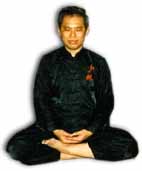TWO CATEGORIES AND TWO APPROACHES OF MEDITATION

Grandmaster Wong in sitting meditation
Active and Passive Meditation
Meditation has been practised since ancient time by different peoples. Although their approaches and immediate objectives may be different, their primary aim is similar, that is the development of mind.
The approaches to meditation may be classified into two broad categories, namely active and passive. In active meditation, the meditator uses his developed mind for achieving a particular and immediate objective, like problem solving or acquiring ESP. In passive meditation, the meditator ignores immediate gains; he aims for long-term accomplishment, which is often spiritual enlightenment. Supernormal abilities occur to him as by-products.
The terms "active" and "passive" may be misleading to some English speaking readers unfamiliar with other languages or cultures. Active meditation is not necessarily more energetic nor demands more effort than passive meditation. In fact, passive meditation is generally more advanced and needs a longer time to achieve its set objectives. Perhaps a rough comparison is that active meditation is fast, while passive meditation is deep.
One-Pointedness and Emptiness
Throughout the ages different peoples have used a great variety of techniques for meditation. But all these techniques can be divided into two main groups, namely those that focus on one point, and those that focus on emptiness. Daniel Goleman, in his informative book "The Meditative Mind", reports a witty statement by Joseph Goldstein.
It's simple mathematics, he said: All meditation systems either aim at One or Zero -- union with God or emptiness. The path to the One is through concentration on Him, to the Zero is insight into the voidness of one's mind.
The Different Streams
In this chapter, we shall examine the major types or streams of meditation from the perspective of historical development. We shall discuss the Chinese, the Indian, the Tibetan, the Japanese and the Western types of meditation, as they not only exhibit different characteristics but also represent the major streams of contribution to the total development of meditation from different areas.
The criterion for classification here is geographical rather than philosophical; discussion based on philosophical classification, such as Buddhist meditation, Yogic Meditation and Christian meditation, will be discussed in the last chapter on the supreme achievement of meditation.
Here we shall discuss the general aims, philosophy and principal techniques of these major types, keeping in mind that there may be great variation or differences within each type. It is almost needless to say that the classification into Chinese, Indian etc. is for the sake of convenient study, certainly not because of any chauvinistic inclinations. Meditation of any types can be, and actually have been, practised and benefited by people of any race, culture or religion.
LINKS
